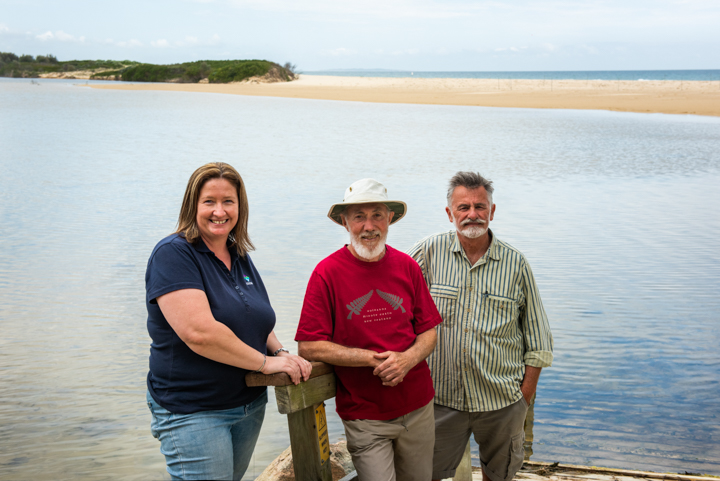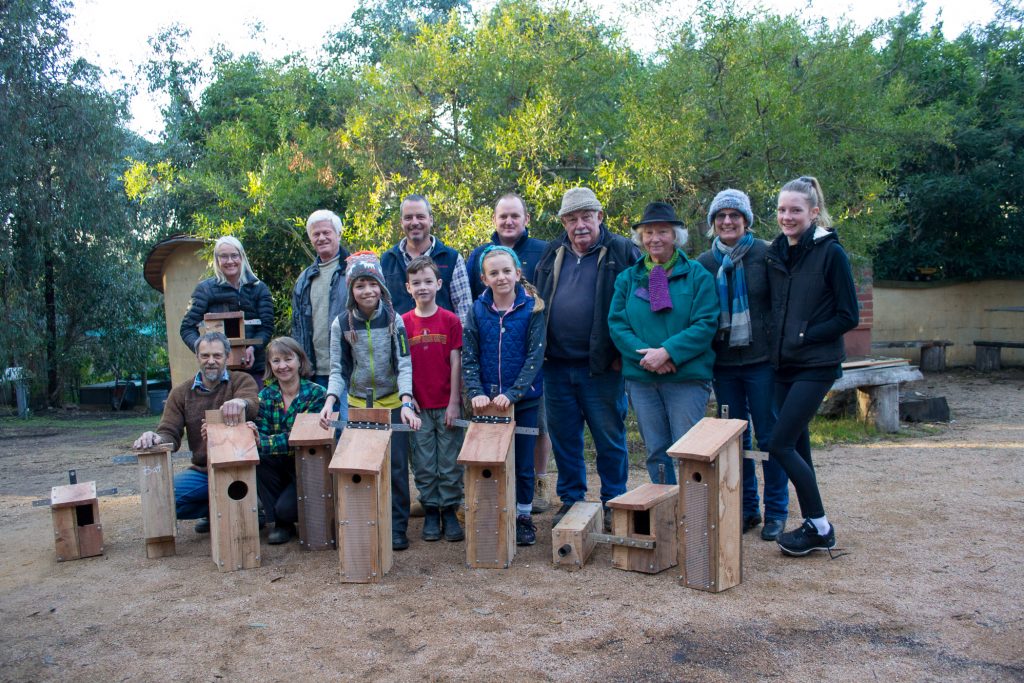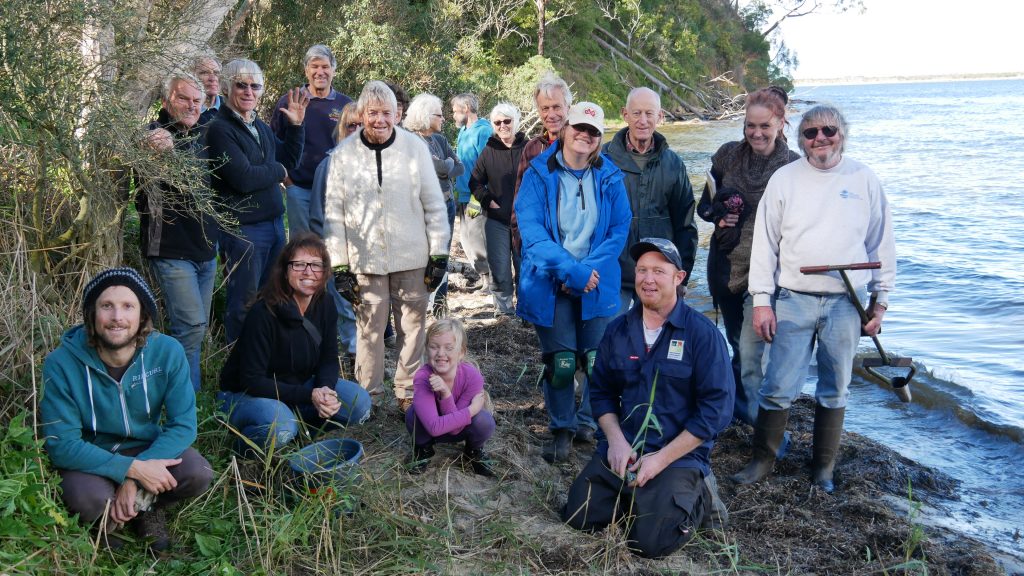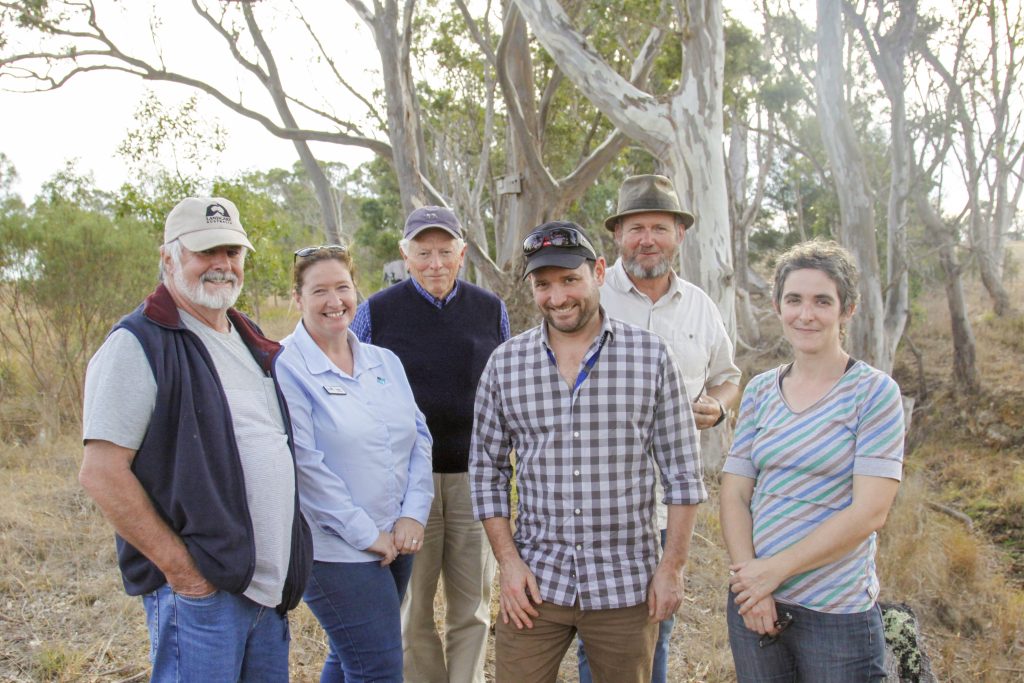
Raymond Island is well known as a relaxing holiday destination with the promise of easy koala spotting and a leisurely lifestyle. Working to improve the bush outlook that visitors travel hundreds of kilometres to enjoy, is a year-round job for the Raymond Island Landcare Group.
For over a decade the group has been systematically improving the health of the island, home to an abundance of wildlife and migratory birds, one plot at a time.
Pam Williams-Wright, the president of the group notes how popular the island has become, “Melbourne is just so busy now that people are looking for somewhere else to retire to and we’re finding that people are moving up having visited the region only a handful of times.” It’s this regeneration of people and enthusiasm and seeing the transformation in real time that keeps the group inspired to continue making a change.
With funding from Victorian Landcare Grants, the group have been working on eight separate sites for over 20 years.
Rob Wright has helped to regenerate 30 acres of bushland since he first moved to the island five years ago. “It’s not complicated” he says, “It’s going to take many years to see the benefits of our hard work but it’s not hard to see what’s already popping up. We’ve got to give back and get it back to something like what it was.“
“Our works have made a huge difference already, especially in the community. People are getting enthusiastic about it, they can see the effects of what we’re doing and that makes a huge difference.”
The Victorian Landcare Grants have recently opened for 2019-20 with grants of up to $20,000 available. If you are a member of a Landcare group or an environmental community group with a great idea for a project on your patch then you should consider applying.
Applications close on 12th June.

Carolyn Cameron from the EGCMA with Martyn Hiley and Max Elliott from the Friends of Mallacoota
Gabo Island might be a remote parcel of land in the most remote pocket of eastern Victoria but it is also home to an ambitious project to remove a highly invasive weed, Mirror bush.
Through funding from the East Gippsland Catchment Management Authority, the Friends of Mallacoota group are working to get rid of the shrub, a native of New Zealand.
Mirrorbush is often planted in coastal gardens because of its tolerance to sea-spray but it is also capable of forming dense clumps that don’t provide any room for native plants to grow and restricts the habitat of native critters and birdlife.
Martyn Hiley, a member of Friends of Mallacoota and regular visitor to Gabo Island recalls “In the past, I’d visit and see the weeds there and think wouldn’t it be nice to do something about that?” And now he is. Three times a year, eight volunteers charter a boat to the island and stay in accommodation provided by Parks Victoria. In four day stints the team use a grid pattern to remove weed from an area around the Lighthouse and they hope that in 5-6 years they will have completed the entire 154 hectare island.
Max Elliott moved to Mallacoota 18 months ago, and he is impressed at the willingness of the community to dig in and lend a hand. “Our Friends group has 130 members which isn’t bad for a town of only a thousand or so people. If somebody wants to get something done then they know they just have to ask, and that’s true of getting weeds off Gabo or removing rubbish from Betka Beach or anything. Town folk are just willing to get in and do and that’s a lovely thing.”
“People can ask why we care about the weeds on Gabo Island” says Martyn, “The people of Mallacoota love Gabo Island and the nice thing about an island is that it’s contained. If we can remove Mirror bush entirely off the island then it may not come back, and that’s a good thing.”
“Because of the hard work of the Friends of Mallacoota, the township is relatively weed free, we’re surrounded by wilderness and it would be nice to see Gabo weed free one day too. “

Landcare Groups across East Gippsland will share in $146,000 of funding for community projects as part of the latest round of Victorian Landcare Grants.
The funding, distributed through the East Gippsland Catchment Management Authority (EGCMA), supports on-ground works and community projects including weed control, pest animal control, protection of habitat, revegetation, and community education.
Graeme Dear, CEO of EGCMA said “the grants will help contribute further to the significant efforts made by our Landcare members in East Gippsland.”
This year the program has funded 12 projects and 11 support grants.
Groups that will receive project funding include:
- Bruthen & District Landcare Group
- Eastwood Landcare Group
- Friends of the Upper Nicholson Catchment Inc.
- Snowy West Landcare Group
- Tambo Bluff Landcare Coastcare
- East Gippsland Landcare Network
- Far East Victoria Landcare
- Snowy River Interstate Landcare Committee
The Victorian Landcare Grants are helping to implement the Government’s long-term biodiversity plan – Protecting Victoria’s Environment – Biodiversity 2037.

Members of the Friends of Picnic Point Reserve (FOPPR) Landcare Group recently celebrated their achievements with a community gathering held at the Picnic Point Reserve.
The group started as a collection of locals concerned with the degradation of the local wetland and a shared vision to restore the natural surrounds. A plan was devised and the group started a concerted effort to restore the 10 acre site.
Picnic Point Reserve is particularly unique containing unusually diverse vegetation including rainforest, grassy woodlands, shrubland and wetland in a relatively small area.
What was initially a neglected public reserve lacking native plants, with slopes covered in ivy and blackberries and erosion problems, has been gradually transformed.
“We started as a group of friends concerned about the degradation of the area.” explained Mary Baldwin, President of the FOPPR. “We just wanted to get rid of the weeds and replant native species to make it a nice public amenity for everyone to use”.
With the assistance of a number of Victorian Landcare Grants over the years, the group has focussed on several key projects throughout the reserve. “The early days were spent removing exotic trees and weeds and developing the wetland area along Yeates Drive. This helps to filter the stormwater from West Bairnsdale that flows into the Mitchell River and out to the lakes.”
Upgraded paths ensure that the area is accessible and a boardwalk over the wetlands provides an alternate route for the public to enjoy. “The reserve is a popular spot for our community, used for picnics, parties and even weddings. The addition of some native flowering plant beds, picnic tables and a picnic shelter on the top of the hill have added to the appeal of the area.”
“The grants have opened up the possibilities of what can be achieved” explains Mary. “Landcare is more important than it’s ever been; it enables people to make a difference to the environment in their community. This is a beautiful patch of land at the doorstep to the Mitchell River and group members had a vision of restoring it to something like its original state. We are all delighted and very proud of how it is developing. However, we would like to emphasise that it will always be a work in progress; there is a need for ongoing weeding and maintenance, new plantings in some areas plus further possible development in the future. New members are always welcome!”
The Victorian Landcare Grants support the implementation of Protecting Victoriaʼs Environment – Biodiversity 2037, the state governmentʼs long-term plan to protect the environment.

Chances are you probably haven’t heard of Hansons Bay, a hidden little gem of a bay just around the corner from Nungurner. It’s an area that the Nungurner Landcare Group know well, particularly the steep sloping section of rainforest leading down to the waters edge.
With the assistance of a Victorian Landcare Grant the group are currently working to regenerate the site. The project has already seen a huge amount of exotic weeds removed and over 600 rainforest species replanted. Unfortunately, pest animals, primarily deer, are also fond of the site and so the group have had to install tree guards to protect the seedlings from being eaten.
“East Gippsland is the only place in Victoria where rainforest to the waters edge is known to occur. This as a long term project to bring the rainforest canopy back” said Louise Avery, Nungurner Landcare Group Secretary. “The weather conditions this year are making things a little tricky for us but we’ve been well supported by the Victorian Landcare Grants and also the East Gippsland Rainforest Conservation Management Network (EGRCMN). We’re lucky that they have lots of volunteers who are willing to work right across the region on rainforest restoration.”
While Nungurner Landcare Group’s primary focus is the restoration of degraded areas around their local patch, the group readily welcome the opportunity to work with other Landcare groups and agencies. “We’re a small but merry band of volunteers” explains Ms Avery.
The group have lent a hand to help the Lakes Entrance Community Landcare Group on their project at Kalimna Gully, assisted Greening Australia and Parks Victoria with a rejuvenation program on Pelican Island and worked with the East Gippsland Shire to improve the amenity of the Nungurner jetty.
Ivan Knight, President of Nungurner Landcare Group appreciates the importance of working together. “We all recognise the value of our natural habitat” he explained. “It just makes it more fun, and you really get a sense of the more people who are involved, the quicker the work gets done so it’s less of a chore.”
“Having like minded people around you to get things done helps you to keep getting things done. We all learn from each other too so it really has paid off for us to work collaboratively and we certainly want to keep doing that as we go forward.”
Nungurner Landcare Group’s Hansons Bay project is funded through the Victorian Landcare Grants supporting the implementation of Protecting Victoriaʼs Environment – Biodiversity 2037, the state governmentʼs long-term plan to protect the environment.
The Victorian Landcare Grants have recently opened for 2018-19 with grants of up to $20,000 available. If you are a member of a Landcare group or an environmental community group with a great idea for a project on your patch then you should consider applying. Applications close on Tuesday 12th June, for more information please visit the East Gippsland Catchment Management Authority website.

Community projects were the focus of a bus tour last week as staff from the East Gippsland Catchment Management Authority (EGCMA) visited four Landcare groups with the Authority’s Community Programs Committee. The day was an opportunity to review current projects and to meet Landcare volunteers who continue to roll up their sleeves to get things done.
The EGCMA administers the Victorian Landcare Grants, Regional Riparian Action Plan Grants and the National Landcare Programme Community Grants on behalf of the state and federal governments each year. The Community Programs Committee is made up of natural resource management agency representatives and community members who review and assess grant applications and recommend which projects should be funded.
The tour began on the East Gippsland Rail Trail at Nicholson. Meryl Wright and Michael Oxer, from the Nicholson River Landcare Group, spoke about their current project to build a new walking path from the rail trail to the river and the importance of the rail trail to the township.
In Bruthen, the long term vision for the Loop Walk project was explained by Geoff Williams from Bruthen & District Landcare Group. The Committee noted the challenges in revegetating an area as flood prone as the banks of the Tambo River.
A stop along the Mitchell River enabled Paul Harvey from the East Gippsland Landcare Network (EGLN) to inform the Committee of EGLN’s involvement with the grants process and also review the progress of recent planting by the Bairnsdale Urban Landcare Group.
Finally, Alistair Mailer from the Romawi Landcare Group discussed the need to stabilise erosion points along Forge Creek and the importance of regular water quality monitoring given the creek flows directly into the Gippsland Lakes.
“Our Landcare and community groups are actively involved in caring for the environment” noted Graeme Dear, CEO of the EGCMA. “And it’s great that both the federal and Victorian Governments are supporting community group partnerships such as these.”
The State Government has recently opened the Victorian Landcare Grants for 2018-19 with grants of up to $20,000 available. If you are a member of a Landcare or environmental volunteer group with a great idea for a project on your patch then you should consider applying. Applications close on Tuesday 12th June, for more information please visit the East Gippsland Catchment Management Authority website.
The Victorian Landcare Grants support the implementation of Protecting Victoriaʼs Environment – Biodiversity 2037, the state governmentʼs long-term plan to protect the environment.


